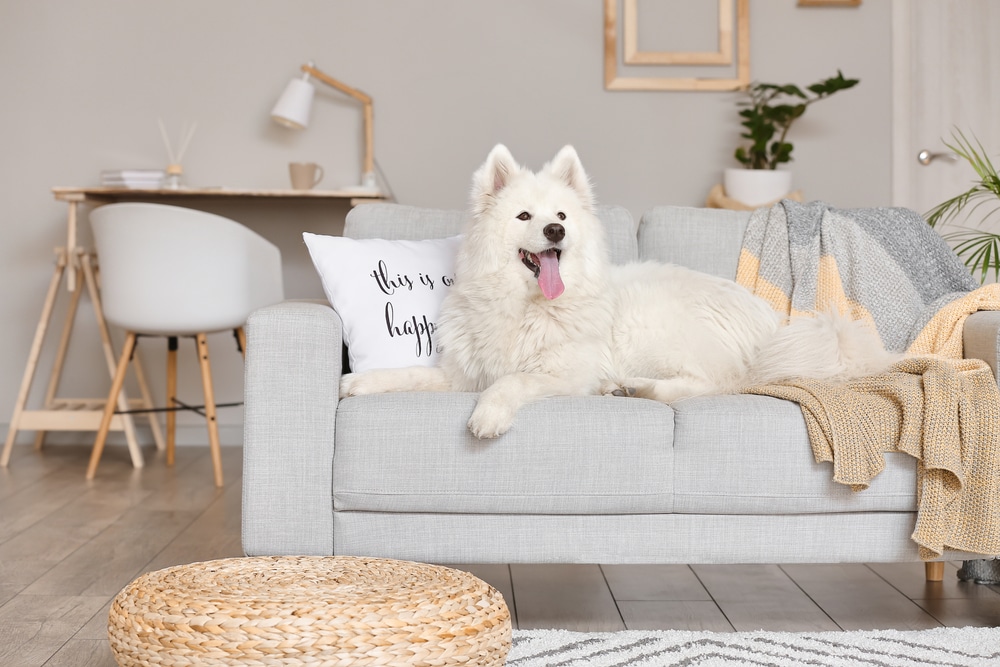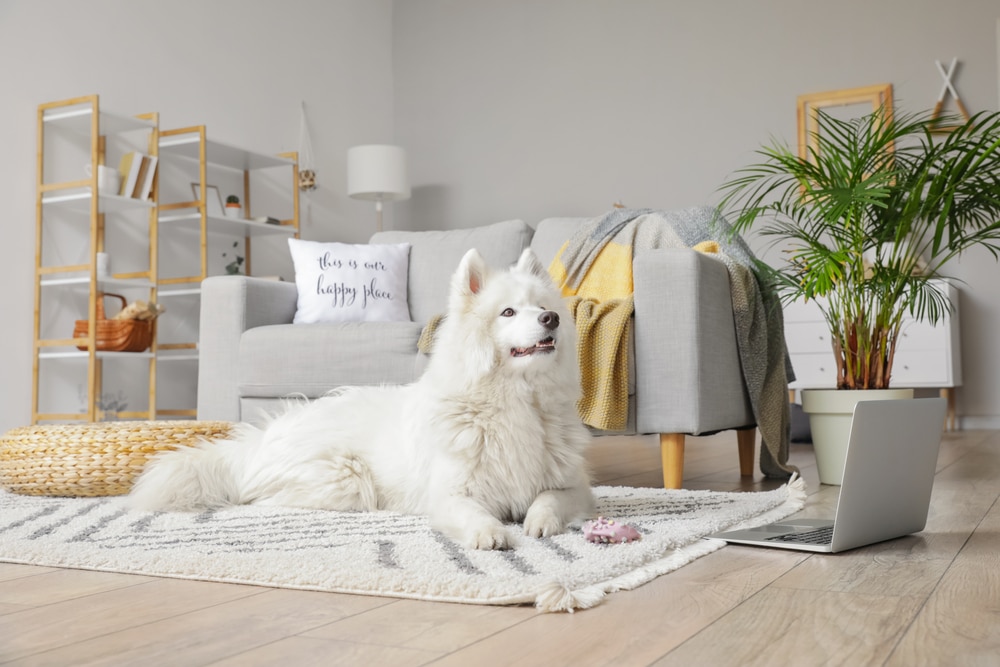Bred for colder conditions but able to handle the heat, it’s important to give these loving dogs the best. But what are the best living conditions for Samoyeds?
The best living conditions for Samoyeds include plenty of space and opportunities for exercise, toys, attention, love, proper nutrition, and a climate that’s not too hot.
Origin And History Of Samoyeds
Samoyeds originated in Siberia located in the far North of Russia. These dogs were domesticated by Nenet people called ‘Samoyeds.’ Those people were nomads who used these dogs for hunting, protection, herding reindeer, and sled pulling.
Also, Samoyeds are closely related to the Spitz family of dogs. Spitz were a family of furry dogs used for herding in the extreme cold of the north pole.
Domestication of these dogs strengthened the human-Samoyed bond and developed a loving relation and understanding seen in modern-day Samoyeds.
Samoyeds were brought outside of Siberia into Europe and America at the start of the 20th century to pull sleds in Arctic and Antarctic expeditions.
Characteristics Of Samoyeds
Samoyeds are a famous breed of dog known for their friendly, playful personality and their thick, fluffy, white shiny coats. They are intelligent, active, and highly energetic dogs that are quite friendly with children and adults.
One of the most unique characteristics of Samoyeds is their thick, fluffy white coats, which are made up of two layers: an outer rough layer made of long hairs and a soft woolly inner layer of thick coat. They also have a distinctive “mane” of longer hairs around their neck and shoulders, which gives them the appearance of a lion.
They have another feature: a ‘smiling’ face that prevents drooling, which prevents the formation of icicles.
As a working dog, Samoyeds are strong-willed. However, temperament-wise, they are quite friendly and playful. They enjoy being around people and other dogs and get bored in a solitary environment. With consistent positive reinforcement, one can easily train these intelligent furry dogs.
How Do Samoyeds Regulate Their Temperature?
Samoyeds are a breed from Siberia and their thick double fur coat allows them to tolerate extreme cold. Their fur keeps them insulated and does not allow the body heat to escape, keeping them warm.
Moreover, the high metabolism of these energetic dogs produce a lot of heat that gets trapped in the fur, which also keeps them well-insulated. In cold weather, the veins constrict and the flow of blood is reduced to keep heat from dissipating from the warm blood.
Can Samoyeds Survive In Warm Weather?
Samoyeds are a breed best suited for cold and normal weather conditions. However, Samoyed are adaptable and can adjust to warm weather conditions.
Surprisingly, the same coat that provides warmth to the Samoyed in cold weather also protects it from sun rays and extreme heat. The inner smooth undercoat keeps a Samoyed insulated and the outer coarser layer of long hairs reflect sun rays, not allowing them to penetrate the skin.
However, although Samoyeds can adapt to warm weather, they don’t like it and may start to pant excessively in extreme hot weather. Therefore, a Samoyed should be kept in a cool place with shade protecting it from the heat. Plenty of cool fresh water should be made available at all times.
Housing For Samoyeds

Spacious and comfortable housing is the first thing that comes to mind when discussing the best living conditions for a Samoyed.
Samoyeds are high-energy dogs and need ample exercise and recreation to keep them fit both physically and mentally. In terms of housing, Samoyeds generally do well in a house with a fenced yard or garden where they can play and explore. They also need access to a warm, dry place to sleep, such as a doghouse or indoor area with a bed.
Guide To Training And Raising A Samoyed Puppy
Raising and training a Samoyed puppy can be a rewarding experience, but it does require time, patience, and consistent effort. Training and raising them properly develops them into a dog that can handle many different types of living conditions.
Here are some valuable tips for raising and training a Samoyed puppy.
Provide Plenty Of Socialization
Samoyeds are generally friendly, outgoing dogs, but it’s important to expose them to a variety of people, places, and experiences during their first few months of life in order to help them develop a well-behaved and amiable personality. This will help them to adjust to their environment and tolerate stress.
Establish A Routine
Samoyeds, like other dogs, thrive on routine and consistency, so it’s important to frame a regular feeding, exercise, and training schedule from an early age.
Early Training
Samoyeds are intelligent, trainable dogs, and it’s important to start training them as early as possible. Begin with basic obedience commands such as “sit,” “stay,” and “come,” and be consistent and patient with your training.
Use Positive Reinforcement
Samoyeds respond well to positive reinforcement, such as treats and praise, so use these rewards to encourage good behavior and discourage bad behavior.
Exercise Regularly
Samoyeds are active, energetic dogs that need plenty of exercise in order to stay healthy and happy. Be sure to provide your puppy with regular opportunities to run, play, and explore in a safe, enclosed area.
Exercise Requirements Of Samoyeds
As discussed earlier, Samoyeds were originally raised in Siberia by the nomads that used these dogs for sled-pulling and herding reindeer. These tasks required an energetic and agile build, and, as a result, these dogs developed powerful muscles and thus needed more exercise to keep them fit and warm in such harsh weather.
Therefore, ample exercise is important for this breed. They will need access to a spacious garden or yard at the very least. Samoyeds should also be given adequate walks twice daily for at least an hour. Moreover, owners should engage in playful activities to keep them active and entertained.
How Often Do Samoyeds Need Grooming?
Samoyeds are a hairy breed with a fluffy coat that is prone to tangles and hair knots if left ungroomed. Therefore, ideally, Samoyeds should be brushed once daily or at least on alternate days. This will shed the old broken hairs and untangle any matted hair from the coat.
In order to achieve a healthy coat, proper nutrition and grooming is essential. Regular bathing every one to two weeks with proper drying and combing will keep the coat smooth and silky.
Feeding A Samoyed For Optimal Health
An ideal feeding plan is one that takes into account the age, body condition, and activity level of a dog. Whether you feed it commercial food or an organic homemade food, all six essential nutrients should be present in a balanced proportion. The six nutrients are carbohydrates, protein, fats, minerals, vitamins, and water. The feeding requirements of an adult differ from that of a puppy.
For instance, a Samoyed pup will need food that has all the nutrients in a balanced proportion, fulfilling the growth requirements of bones and muscles.
Here is a guideline of feeding a Samoyed in different life stages.
Puppies
Puppies have different nutritional needs than adult dogs and will require a diet that is specifically formulated for growing dogs. It is important to feed your Samoyed puppy high-quality puppy food that is rich in protein and other essential nutrients. Puppies should be fed four to five times per day, with the amount of food gradually increasing as they grow.
Adults
Adult Samoyeds should be fed a high-quality diet that is formulated for their size and activity level. The amount of food an adult Samoyed requires will depend on its size and activity level. As a general rule though, they should be fed two to three times per day. It is important to monitor your dog’s weight and adjust the amount of food accordingly to prevent obesity.
Senior Samoyeds
As Samoyeds age, their nutritional needs may change. Senior dogs may require a diet that is lower in calories and higher in fiber to help maintain a healthy weight and balance the microflora of the gastrointestinal tract. Senior dogs need more protein compared to adults to fuel their muscles because old dogs start to lose muscle mass as they age.
Overall, it is important to feed your Samoyed a high-quality diet that is appropriate for their age and activity level. This will help ensure that they receive the nutrients they need to maintain good health and optimal energy levels.
Conclusion: Best Living Conditions For Samoyeds
Samoyeds are a unique breed with body anatomy and characteristics that differs from other dog breeds. Samoyeds are a fluffy dog breed with thick coats. Although they can adapt well to the extremes of weather, they should be provided with a warm, comfortable bedding.
Ample space should also be provided for adequate exercise and recreation, they should be groomed regularly, and lastly, and they should be fed a balanced diet to keep them warm and healthy.
All of the above are the best living conditions for Samoyeds.
So, what do you think about the best living conditions for Samoyeds? Do you have any more suggestions? Let us know in the comments below!
